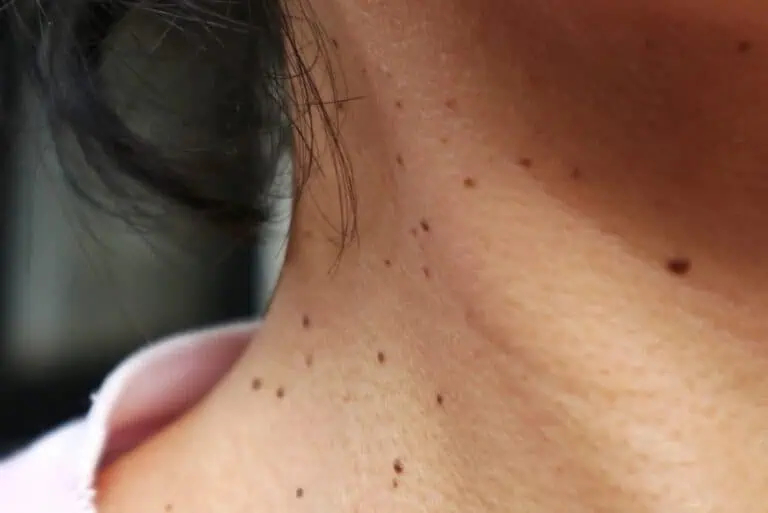How to Get Rid of Skin Tags Without Hurting Yourself

Skin tags are incredibly common and completely harmless. There’s no need to remove these fleshy little growths that protrude or hang from the skin—but plenty of people prefer to get rid of them, either because they rub against their clothes or they simply look unattractive. Want to know how to get rid of skin tags? Rule number one: Don’t try to do it yourself. There are good reasons to leave skin tag removal to a dermatologist.
What are skin tags?
Skin tags (medical term: acrochordons) are soft, noncancerous tumors made up of collagen fibers, nerve cells and small blood vessels wrapped in layers of skin. They may take the form of flat bumps or growths that dangle from the skin on a short, thin stalk. Skin tags are usually small (2 to 5 millimeters), but some can become as long as half an inch. They may be the same color as your skin or darker.
These growths can appear on any part of your body, but they’re most likely to develop in areas where skin rubs against skin, creating friction. Common locations include the armpits, eyelids, groin and beneath the breasts. Skin tags on the neck are also common, possibly due to clothes or jewelry rubbing against the neck.
If a skin tag becomes uncomfortable or irritated, or it bleeds, skin tag removal may be recommended. This tends to happen if a skin tag is located in an area you shave or where clothing, jewelry or a seat belt rubs against it. It’s also fine to have a skin tag removed just because its appearance bothers you.
What causes skin tags?
The causes of skin tags are unclear, but there are several possible triggers in addition to friction. You’re more likely to get skin tags if you:
-
- Are obese or have loose, sagging skin, which creates more skin folds
- Have relatives with skin tags
- Have diabetes or metabolic syndrome, a group of conditions that include high blood pressure and high blood sugar
- Have Crohn’s disease (an inflammatory bowel disease) or colon polyps
- Are pregnant
- Have a hormonal condition such as acromegaly (an excess of growth hormone) or polycystic ovary syndrome
- Have acanthosis nigricans, a skin condition that causes dark, velvety patches
Dangers of skin tag removal at home
Tempted to get rid of skin tags yourself? As badly as you may want them gone, cutting or clipping them off hurts—a lot. And it can cause uncontrollable bleeding and infection. The damage may be even worse if you use nail clippers or scissors on skin tags near your eye or genitals.
There’s an even bigger risk to home remedies for skin tags, however: The growth you try to remove may not be a skin tag at all.
“I often find in our practice that a patient comes in complaining of a “skin tag” and it is in fact a mole or even a skin cancer” said Gia Edge, an APRN with Riverchase Dermatology. Trying to remove one of these growths at home could worsen the lesion and delay a medical diagnosis.
Even seemingly safer home remedies for skin tags may not work, and they aren’t without risk. “I would strongly advise against home remedies such as tea tree oil or apple cider vinegar because most of the time they will lead to a secondary condition that can cause a rash,” said Edge. Over-the-counter skin tag remover products such as freezing kits and patches can cause scarring, bleeding and damage to the surrounding skin.
Skip the “tie off the skin tag with dental floss” strategy, too. While it’s sometimes effective on smaller skin tags, this approach can take a long time to work, and it’s not worth the pain and increased risk of infection. Also, you don’t want to find out what a decaying skin tag smells like (hint: it’s not pleasant).
Removing skin tags: How dermatologists do it
Professional skin tag removal is a safer, quicker and nearly painless process. Plus, your dermatologist can confirm that your growths are in fact skin tags and not warts, moles, seborrheic keratoses, molluscum contagiosum or skin cancer.
Depending on the size and location of the skin tags, your dermatology provider may use one of the following skin tag removal techniques.
Excision
If your skin tags are small, the dermatologist may snip them off with surgical scissors or, for larger skin tags, shave them off. They may inject a numbing medication into the area first.
Cryosurgery with liquid nitrogen
Liquid nitrogen, a very cold gas, is applied to the skin tag or its stalk to freeze it, which destroys the tissue. The procedure tends to cause a brief stinging or burning sensation. You can expect the skin tag to fall off in about 10 to 14 days. Cryosurgery is often used for thicker skin tags.
Electrocauterization
Some dermatologists use electrocauterization for thicker skin tags and skin tags in delicate areas such as the eyelids. In this procedure, a pen-like device delivers a heated electrical current to burn off the skin tag. You’ll develop a scab, which disappears in one to three weeks.
After any of these procedures, you’ll need to keep the treated area clean, and you may be advised to cover it with a bandage for a few days to prevent friction. Applying petroleum jelly while the skin heals can help prevent or reduce scarring. Using sunscreen is a must.
If a beloved necklace triggered the growth of skin tags on your neck, consider putting it away or at least removing it in the evening so the skin tags are less likely to return.
Medically reviewed by Gia Edge, APRN
Written by Jessica Brown, a health and science writer/editor based in Nanuet, New York. She has written for Water’s Edge Dermatology, Prevention magazine, jnj.com, BCRF.org, and many other outlets.


